BUS709 Communication in Business: Personal Reflection and Learnings
VerifiedAdded on 2023/06/11
|7
|1890
|80
Essay
AI Summary
This essay reflects on the BUS709 Communication in Business course, detailing the student's journey from initial reluctance to confident application of communication skills. It covers key concepts such as the difference between communication and communications, Priestly Paradox, characteristics of effective communication models, criticisms of communication modes, and barriers to communication like noise and information distortion. The essay also discusses the importance of feedback, various communication channels within an organization (downward, upward, horizontal), and the significance of open and transparent communication for business success. The student emphasizes the practical benefits of the acquired knowledge and its potential impact on their career and future organizations. The essay concludes with a positive reflection on the course experience and the value of the learned skills.
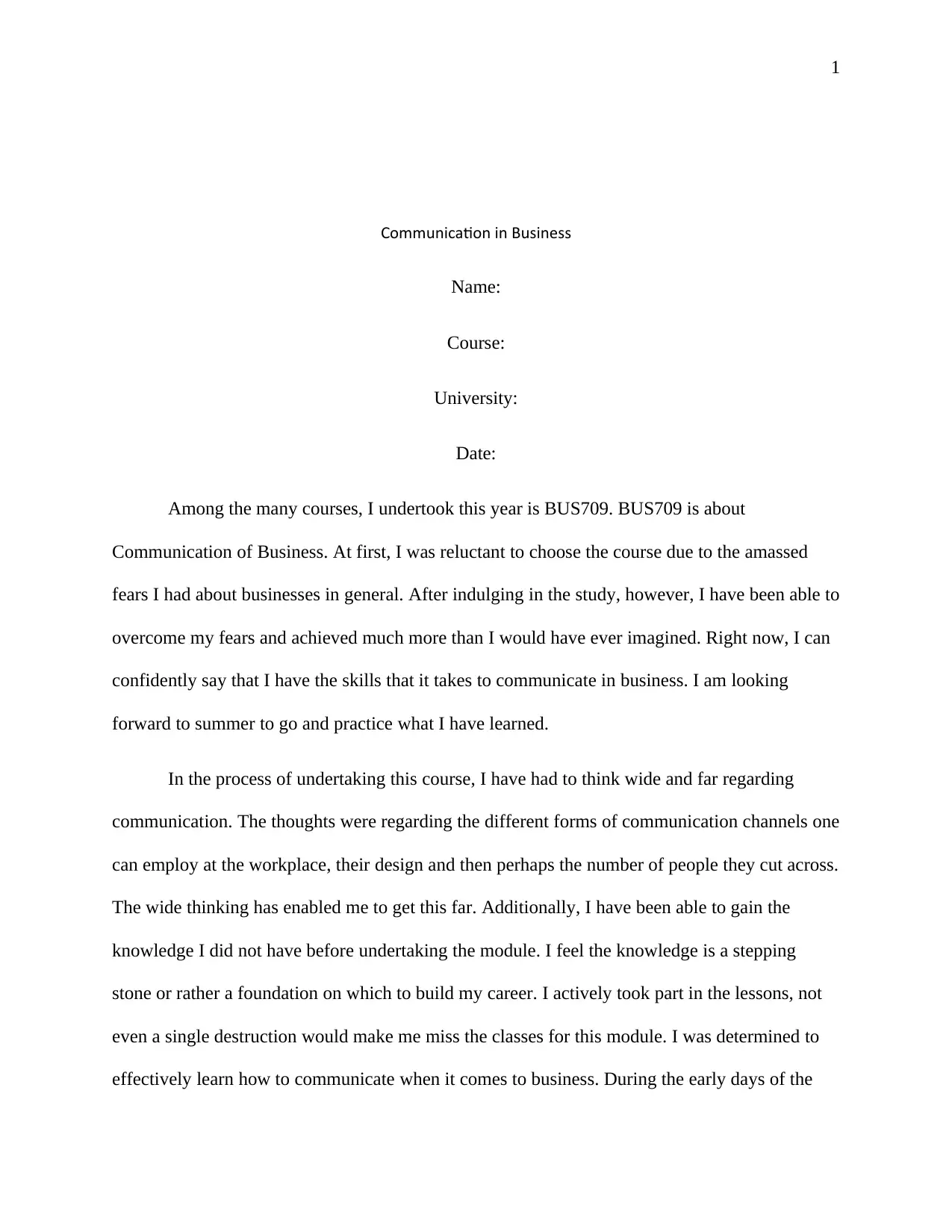
1
Communication in Business
Name:
Course:
University:
Date:
Among the many courses, I undertook this year is BUS709. BUS709 is about
Communication of Business. At first, I was reluctant to choose the course due to the amassed
fears I had about businesses in general. After indulging in the study, however, I have been able to
overcome my fears and achieved much more than I would have ever imagined. Right now, I can
confidently say that I have the skills that it takes to communicate in business. I am looking
forward to summer to go and practice what I have learned.
In the process of undertaking this course, I have had to think wide and far regarding
communication. The thoughts were regarding the different forms of communication channels one
can employ at the workplace, their design and then perhaps the number of people they cut across.
The wide thinking has enabled me to get this far. Additionally, I have been able to gain the
knowledge I did not have before undertaking the module. I feel the knowledge is a stepping
stone or rather a foundation on which to build my career. I actively took part in the lessons, not
even a single destruction would make me miss the classes for this module. I was determined to
effectively learn how to communicate when it comes to business. During the early days of the
Communication in Business
Name:
Course:
University:
Date:
Among the many courses, I undertook this year is BUS709. BUS709 is about
Communication of Business. At first, I was reluctant to choose the course due to the amassed
fears I had about businesses in general. After indulging in the study, however, I have been able to
overcome my fears and achieved much more than I would have ever imagined. Right now, I can
confidently say that I have the skills that it takes to communicate in business. I am looking
forward to summer to go and practice what I have learned.
In the process of undertaking this course, I have had to think wide and far regarding
communication. The thoughts were regarding the different forms of communication channels one
can employ at the workplace, their design and then perhaps the number of people they cut across.
The wide thinking has enabled me to get this far. Additionally, I have been able to gain the
knowledge I did not have before undertaking the module. I feel the knowledge is a stepping
stone or rather a foundation on which to build my career. I actively took part in the lessons, not
even a single destruction would make me miss the classes for this module. I was determined to
effectively learn how to communicate when it comes to business. During the early days of the
Paraphrase This Document
Need a fresh take? Get an instant paraphrase of this document with our AI Paraphraser
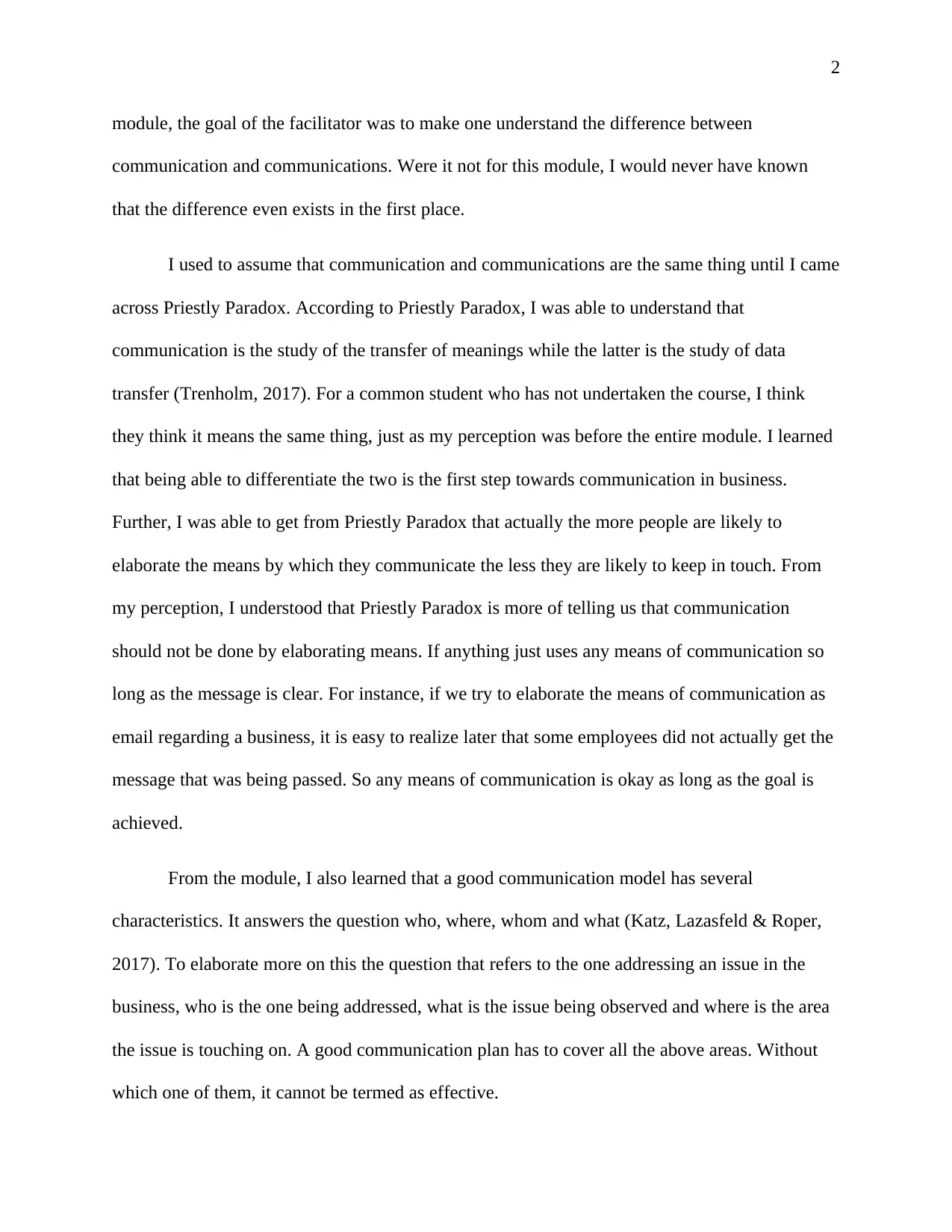
2
module, the goal of the facilitator was to make one understand the difference between
communication and communications. Were it not for this module, I would never have known
that the difference even exists in the first place.
I used to assume that communication and communications are the same thing until I came
across Priestly Paradox. According to Priestly Paradox, I was able to understand that
communication is the study of the transfer of meanings while the latter is the study of data
transfer (Trenholm, 2017). For a common student who has not undertaken the course, I think
they think it means the same thing, just as my perception was before the entire module. I learned
that being able to differentiate the two is the first step towards communication in business.
Further, I was able to get from Priestly Paradox that actually the more people are likely to
elaborate the means by which they communicate the less they are likely to keep in touch. From
my perception, I understood that Priestly Paradox is more of telling us that communication
should not be done by elaborating means. If anything just uses any means of communication so
long as the message is clear. For instance, if we try to elaborate the means of communication as
email regarding a business, it is easy to realize later that some employees did not actually get the
message that was being passed. So any means of communication is okay as long as the goal is
achieved.
From the module, I also learned that a good communication model has several
characteristics. It answers the question who, where, whom and what (Katz, Lazasfeld & Roper,
2017). To elaborate more on this the question that refers to the one addressing an issue in the
business, who is the one being addressed, what is the issue being observed and where is the area
the issue is touching on. A good communication plan has to cover all the above areas. Without
which one of them, it cannot be termed as effective.
module, the goal of the facilitator was to make one understand the difference between
communication and communications. Were it not for this module, I would never have known
that the difference even exists in the first place.
I used to assume that communication and communications are the same thing until I came
across Priestly Paradox. According to Priestly Paradox, I was able to understand that
communication is the study of the transfer of meanings while the latter is the study of data
transfer (Trenholm, 2017). For a common student who has not undertaken the course, I think
they think it means the same thing, just as my perception was before the entire module. I learned
that being able to differentiate the two is the first step towards communication in business.
Further, I was able to get from Priestly Paradox that actually the more people are likely to
elaborate the means by which they communicate the less they are likely to keep in touch. From
my perception, I understood that Priestly Paradox is more of telling us that communication
should not be done by elaborating means. If anything just uses any means of communication so
long as the message is clear. For instance, if we try to elaborate the means of communication as
email regarding a business, it is easy to realize later that some employees did not actually get the
message that was being passed. So any means of communication is okay as long as the goal is
achieved.
From the module, I also learned that a good communication model has several
characteristics. It answers the question who, where, whom and what (Katz, Lazasfeld & Roper,
2017). To elaborate more on this the question that refers to the one addressing an issue in the
business, who is the one being addressed, what is the issue being observed and where is the area
the issue is touching on. A good communication plan has to cover all the above areas. Without
which one of them, it cannot be termed as effective.
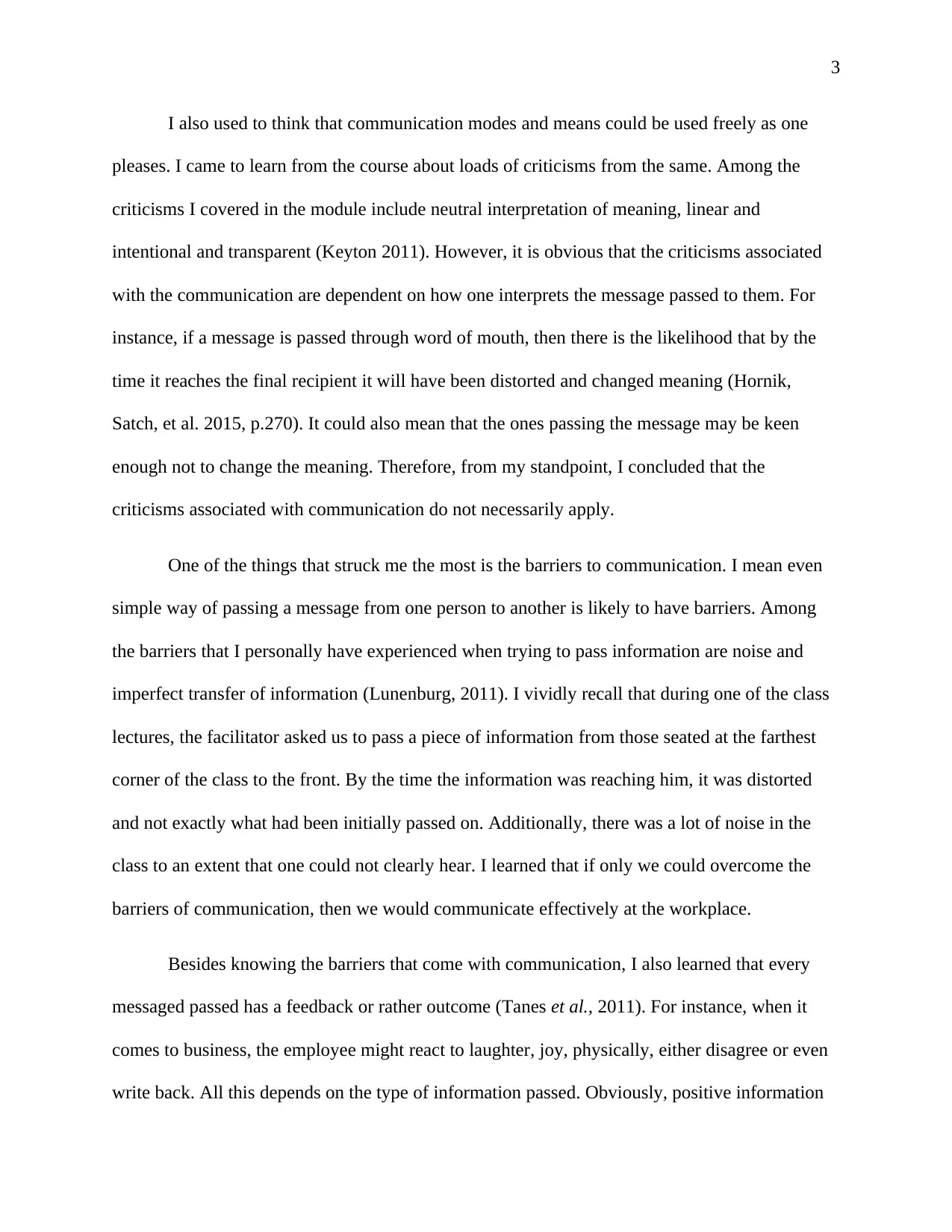
3
I also used to think that communication modes and means could be used freely as one
pleases. I came to learn from the course about loads of criticisms from the same. Among the
criticisms I covered in the module include neutral interpretation of meaning, linear and
intentional and transparent (Keyton 2011). However, it is obvious that the criticisms associated
with the communication are dependent on how one interprets the message passed to them. For
instance, if a message is passed through word of mouth, then there is the likelihood that by the
time it reaches the final recipient it will have been distorted and changed meaning (Hornik,
Satch, et al. 2015, p.270). It could also mean that the ones passing the message may be keen
enough not to change the meaning. Therefore, from my standpoint, I concluded that the
criticisms associated with communication do not necessarily apply.
One of the things that struck me the most is the barriers to communication. I mean even
simple way of passing a message from one person to another is likely to have barriers. Among
the barriers that I personally have experienced when trying to pass information are noise and
imperfect transfer of information (Lunenburg, 2011). I vividly recall that during one of the class
lectures, the facilitator asked us to pass a piece of information from those seated at the farthest
corner of the class to the front. By the time the information was reaching him, it was distorted
and not exactly what had been initially passed on. Additionally, there was a lot of noise in the
class to an extent that one could not clearly hear. I learned that if only we could overcome the
barriers of communication, then we would communicate effectively at the workplace.
Besides knowing the barriers that come with communication, I also learned that every
messaged passed has a feedback or rather outcome (Tanes et al., 2011). For instance, when it
comes to business, the employee might react to laughter, joy, physically, either disagree or even
write back. All this depends on the type of information passed. Obviously, positive information
I also used to think that communication modes and means could be used freely as one
pleases. I came to learn from the course about loads of criticisms from the same. Among the
criticisms I covered in the module include neutral interpretation of meaning, linear and
intentional and transparent (Keyton 2011). However, it is obvious that the criticisms associated
with the communication are dependent on how one interprets the message passed to them. For
instance, if a message is passed through word of mouth, then there is the likelihood that by the
time it reaches the final recipient it will have been distorted and changed meaning (Hornik,
Satch, et al. 2015, p.270). It could also mean that the ones passing the message may be keen
enough not to change the meaning. Therefore, from my standpoint, I concluded that the
criticisms associated with communication do not necessarily apply.
One of the things that struck me the most is the barriers to communication. I mean even
simple way of passing a message from one person to another is likely to have barriers. Among
the barriers that I personally have experienced when trying to pass information are noise and
imperfect transfer of information (Lunenburg, 2011). I vividly recall that during one of the class
lectures, the facilitator asked us to pass a piece of information from those seated at the farthest
corner of the class to the front. By the time the information was reaching him, it was distorted
and not exactly what had been initially passed on. Additionally, there was a lot of noise in the
class to an extent that one could not clearly hear. I learned that if only we could overcome the
barriers of communication, then we would communicate effectively at the workplace.
Besides knowing the barriers that come with communication, I also learned that every
messaged passed has a feedback or rather outcome (Tanes et al., 2011). For instance, when it
comes to business, the employee might react to laughter, joy, physically, either disagree or even
write back. All this depends on the type of information passed. Obviously, positive information
⊘ This is a preview!⊘
Do you want full access?
Subscribe today to unlock all pages.

Trusted by 1+ million students worldwide
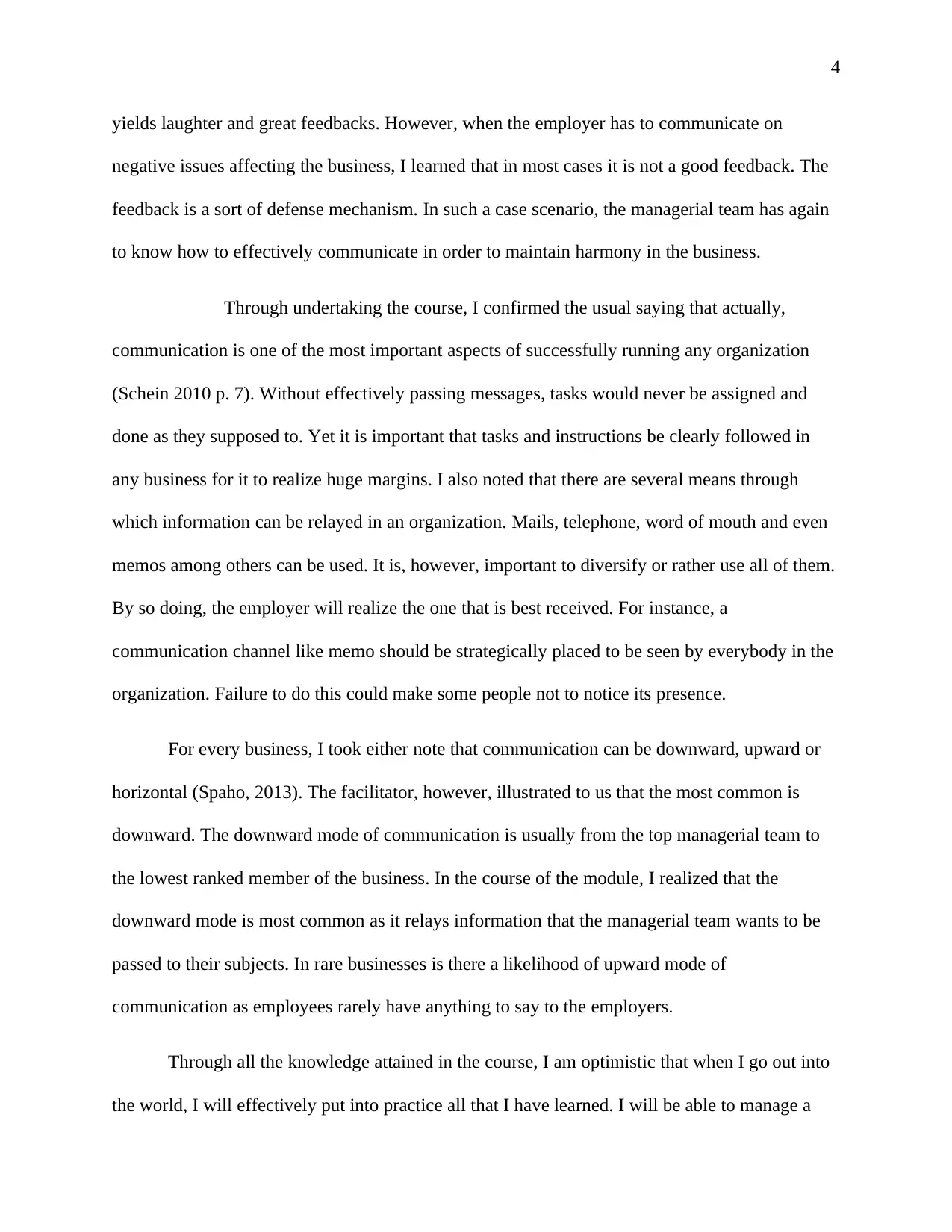
4
yields laughter and great feedbacks. However, when the employer has to communicate on
negative issues affecting the business, I learned that in most cases it is not a good feedback. The
feedback is a sort of defense mechanism. In such a case scenario, the managerial team has again
to know how to effectively communicate in order to maintain harmony in the business.
Through undertaking the course, I confirmed the usual saying that actually,
communication is one of the most important aspects of successfully running any organization
(Schein 2010 p. 7). Without effectively passing messages, tasks would never be assigned and
done as they supposed to. Yet it is important that tasks and instructions be clearly followed in
any business for it to realize huge margins. I also noted that there are several means through
which information can be relayed in an organization. Mails, telephone, word of mouth and even
memos among others can be used. It is, however, important to diversify or rather use all of them.
By so doing, the employer will realize the one that is best received. For instance, a
communication channel like memo should be strategically placed to be seen by everybody in the
organization. Failure to do this could make some people not to notice its presence.
For every business, I took either note that communication can be downward, upward or
horizontal (Spaho, 2013). The facilitator, however, illustrated to us that the most common is
downward. The downward mode of communication is usually from the top managerial team to
the lowest ranked member of the business. In the course of the module, I realized that the
downward mode is most common as it relays information that the managerial team wants to be
passed to their subjects. In rare businesses is there a likelihood of upward mode of
communication as employees rarely have anything to say to the employers.
Through all the knowledge attained in the course, I am optimistic that when I go out into
the world, I will effectively put into practice all that I have learned. I will be able to manage a
yields laughter and great feedbacks. However, when the employer has to communicate on
negative issues affecting the business, I learned that in most cases it is not a good feedback. The
feedback is a sort of defense mechanism. In such a case scenario, the managerial team has again
to know how to effectively communicate in order to maintain harmony in the business.
Through undertaking the course, I confirmed the usual saying that actually,
communication is one of the most important aspects of successfully running any organization
(Schein 2010 p. 7). Without effectively passing messages, tasks would never be assigned and
done as they supposed to. Yet it is important that tasks and instructions be clearly followed in
any business for it to realize huge margins. I also noted that there are several means through
which information can be relayed in an organization. Mails, telephone, word of mouth and even
memos among others can be used. It is, however, important to diversify or rather use all of them.
By so doing, the employer will realize the one that is best received. For instance, a
communication channel like memo should be strategically placed to be seen by everybody in the
organization. Failure to do this could make some people not to notice its presence.
For every business, I took either note that communication can be downward, upward or
horizontal (Spaho, 2013). The facilitator, however, illustrated to us that the most common is
downward. The downward mode of communication is usually from the top managerial team to
the lowest ranked member of the business. In the course of the module, I realized that the
downward mode is most common as it relays information that the managerial team wants to be
passed to their subjects. In rare businesses is there a likelihood of upward mode of
communication as employees rarely have anything to say to the employers.
Through all the knowledge attained in the course, I am optimistic that when I go out into
the world, I will effectively put into practice all that I have learned. I will be able to manage a
Paraphrase This Document
Need a fresh take? Get an instant paraphrase of this document with our AI Paraphraser
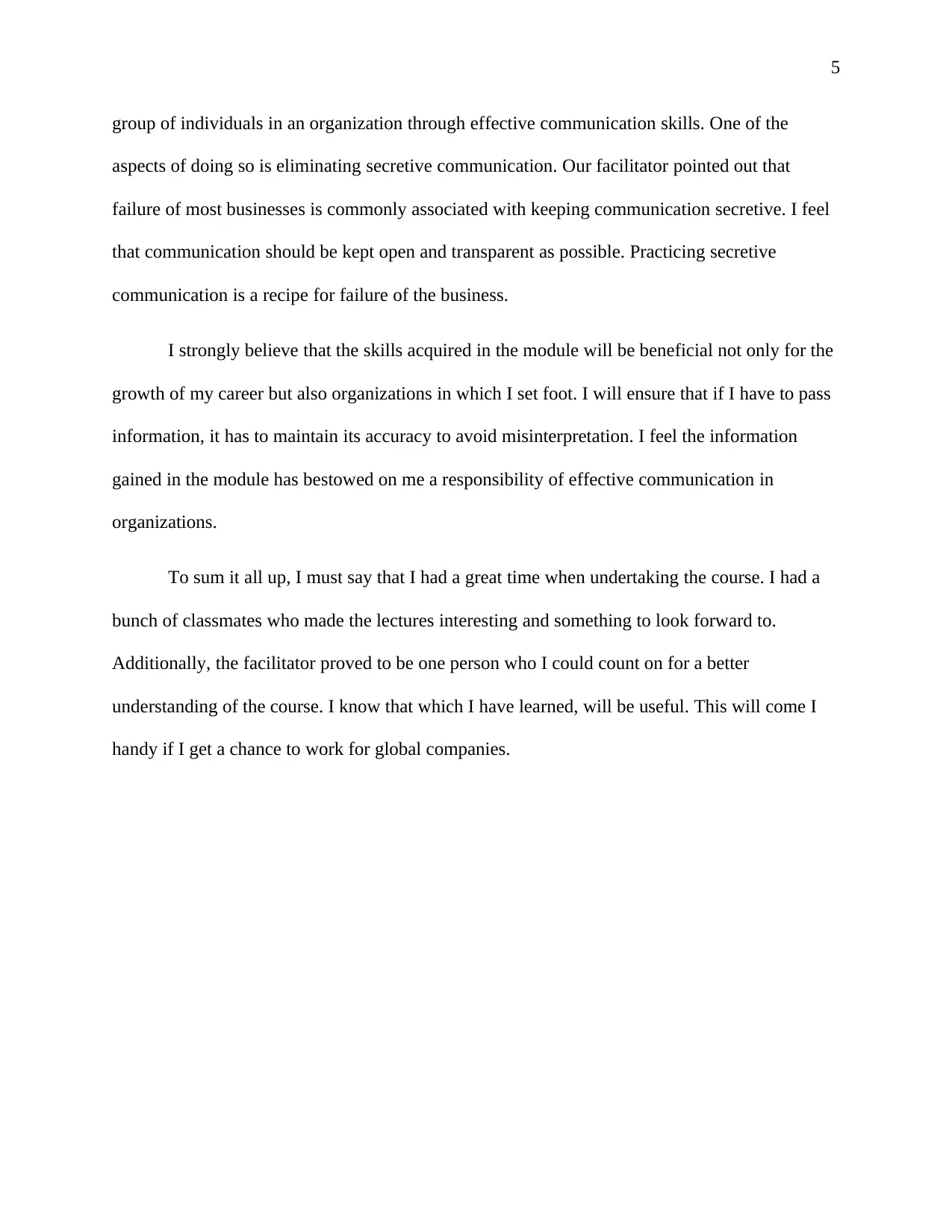
5
group of individuals in an organization through effective communication skills. One of the
aspects of doing so is eliminating secretive communication. Our facilitator pointed out that
failure of most businesses is commonly associated with keeping communication secretive. I feel
that communication should be kept open and transparent as possible. Practicing secretive
communication is a recipe for failure of the business.
I strongly believe that the skills acquired in the module will be beneficial not only for the
growth of my career but also organizations in which I set foot. I will ensure that if I have to pass
information, it has to maintain its accuracy to avoid misinterpretation. I feel the information
gained in the module has bestowed on me a responsibility of effective communication in
organizations.
To sum it all up, I must say that I had a great time when undertaking the course. I had a
bunch of classmates who made the lectures interesting and something to look forward to.
Additionally, the facilitator proved to be one person who I could count on for a better
understanding of the course. I know that which I have learned, will be useful. This will come I
handy if I get a chance to work for global companies.
group of individuals in an organization through effective communication skills. One of the
aspects of doing so is eliminating secretive communication. Our facilitator pointed out that
failure of most businesses is commonly associated with keeping communication secretive. I feel
that communication should be kept open and transparent as possible. Practicing secretive
communication is a recipe for failure of the business.
I strongly believe that the skills acquired in the module will be beneficial not only for the
growth of my career but also organizations in which I set foot. I will ensure that if I have to pass
information, it has to maintain its accuracy to avoid misinterpretation. I feel the information
gained in the module has bestowed on me a responsibility of effective communication in
organizations.
To sum it all up, I must say that I had a great time when undertaking the course. I had a
bunch of classmates who made the lectures interesting and something to look forward to.
Additionally, the facilitator proved to be one person who I could count on for a better
understanding of the course. I know that which I have learned, will be useful. This will come I
handy if I get a chance to work for global companies.
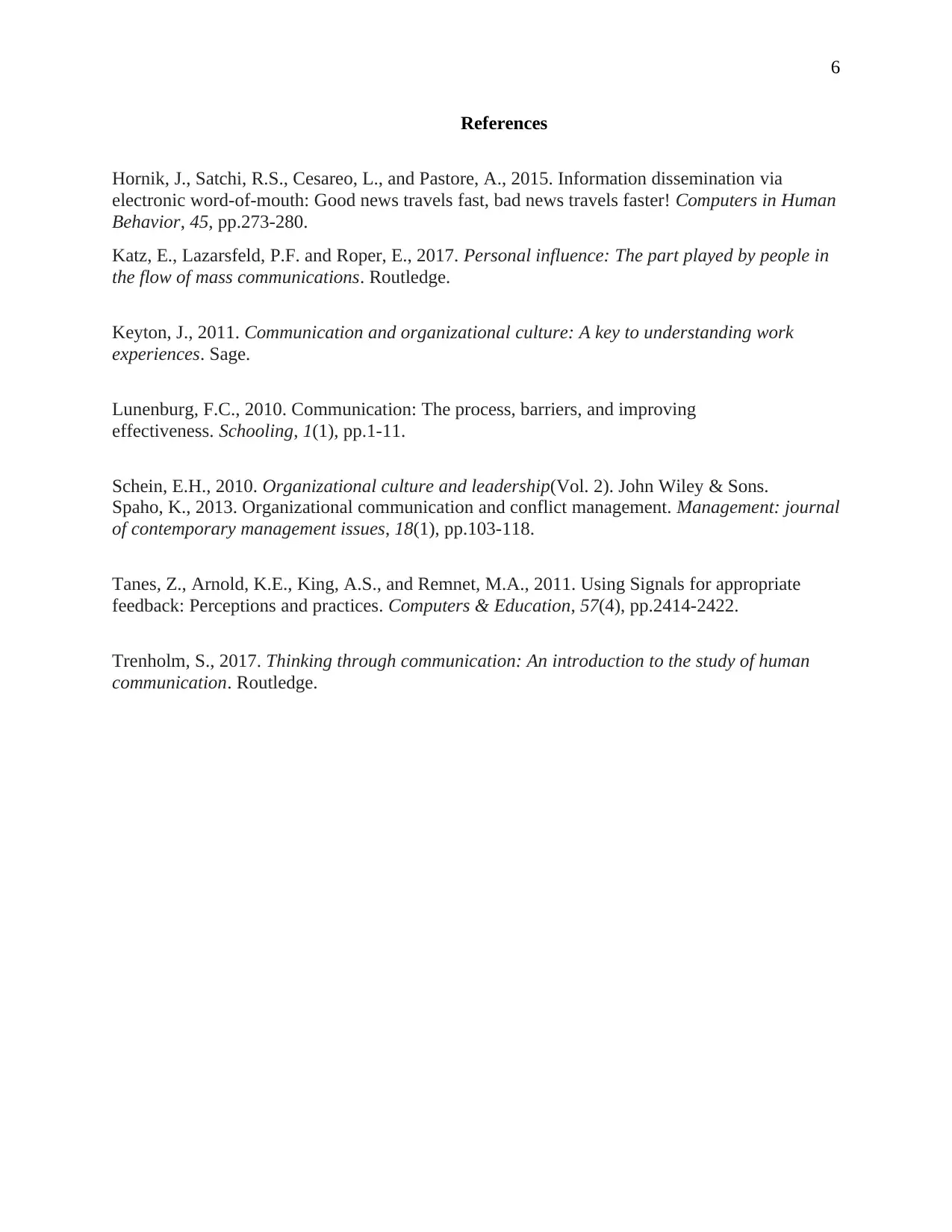
6
References
Hornik, J., Satchi, R.S., Cesareo, L., and Pastore, A., 2015. Information dissemination via
electronic word-of-mouth: Good news travels fast, bad news travels faster! Computers in Human
Behavior, 45, pp.273-280.
Katz, E., Lazarsfeld, P.F. and Roper, E., 2017. Personal influence: The part played by people in
the flow of mass communications. Routledge.
Keyton, J., 2011. Communication and organizational culture: A key to understanding work
experiences. Sage.
Lunenburg, F.C., 2010. Communication: The process, barriers, and improving
effectiveness. Schooling, 1(1), pp.1-11.
Schein, E.H., 2010. Organizational culture and leadership(Vol. 2). John Wiley & Sons.
Spaho, K., 2013. Organizational communication and conflict management. Management: journal
of contemporary management issues, 18(1), pp.103-118.
Tanes, Z., Arnold, K.E., King, A.S., and Remnet, M.A., 2011. Using Signals for appropriate
feedback: Perceptions and practices. Computers & Education, 57(4), pp.2414-2422.
Trenholm, S., 2017. Thinking through communication: An introduction to the study of human
communication. Routledge.
References
Hornik, J., Satchi, R.S., Cesareo, L., and Pastore, A., 2015. Information dissemination via
electronic word-of-mouth: Good news travels fast, bad news travels faster! Computers in Human
Behavior, 45, pp.273-280.
Katz, E., Lazarsfeld, P.F. and Roper, E., 2017. Personal influence: The part played by people in
the flow of mass communications. Routledge.
Keyton, J., 2011. Communication and organizational culture: A key to understanding work
experiences. Sage.
Lunenburg, F.C., 2010. Communication: The process, barriers, and improving
effectiveness. Schooling, 1(1), pp.1-11.
Schein, E.H., 2010. Organizational culture and leadership(Vol. 2). John Wiley & Sons.
Spaho, K., 2013. Organizational communication and conflict management. Management: journal
of contemporary management issues, 18(1), pp.103-118.
Tanes, Z., Arnold, K.E., King, A.S., and Remnet, M.A., 2011. Using Signals for appropriate
feedback: Perceptions and practices. Computers & Education, 57(4), pp.2414-2422.
Trenholm, S., 2017. Thinking through communication: An introduction to the study of human
communication. Routledge.
⊘ This is a preview!⊘
Do you want full access?
Subscribe today to unlock all pages.

Trusted by 1+ million students worldwide

7
1 out of 7
Related Documents
Your All-in-One AI-Powered Toolkit for Academic Success.
+13062052269
info@desklib.com
Available 24*7 on WhatsApp / Email
![[object Object]](/_next/static/media/star-bottom.7253800d.svg)
Unlock your academic potential
Copyright © 2020–2025 A2Z Services. All Rights Reserved. Developed and managed by ZUCOL.




